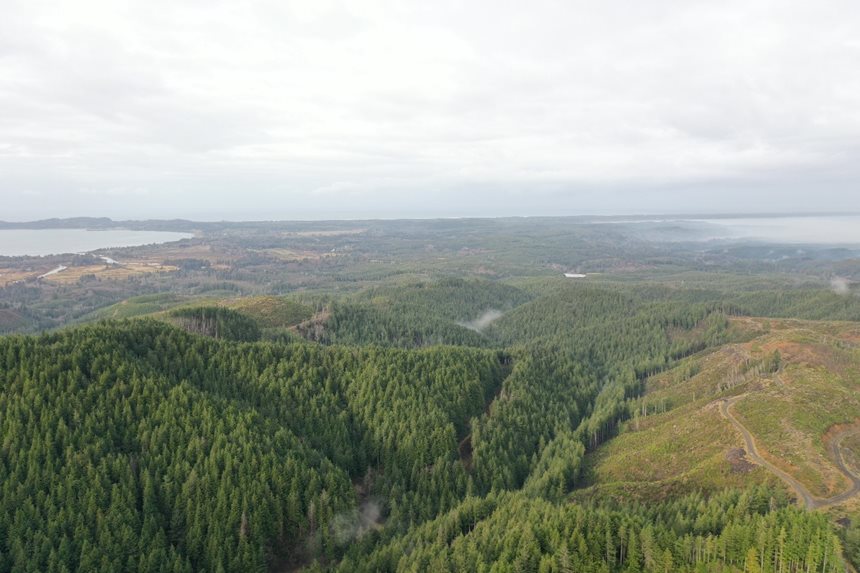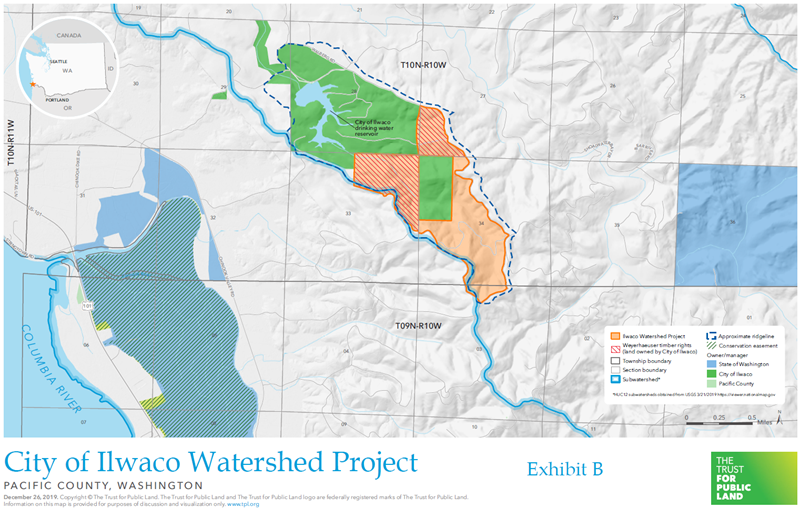
The view from Bear Ridge Community Forest, now fully owned by the City of Ilwaco, looking west to the coast.
Every year, our grants and loans teams review hundreds of applications for funding. In fact, this year we received 151 applications for $364 million in clean-water project funding. As our team reviews and ranks these projects, sometimes they come across a project that has a lot of potential but needs some additional support to make the project a reality.
That was the case with the City of Ilwaco’s Bear Ridge Community Forest acquisition. The wheels started to turn on this project a few years ago, and we are happy to announce that, with funding support from us and other partners, the City has now completed a large-scale acquisition of land and timber rights that will help protect their drinking water reservoir.
This is a unique project for us, and we are excited to share more about this partnership.
Protecting Ilwaco’s drinking water
Ilwaco residents get their drinking water from Indian Creek and its tributaries, about 5.5 miles east of the city. The water is impounded in a dam, creating the Indian Creek Reservoir. The reservoir is then supplied by regular rainfall within the watershed.
This area has a long history of timber production. In the 1970s, the City of Ilwaco purchased land from Weyerhaeuser, a timberland company, to create the impoundment (earthen dam) establishing the Indian Creek reservoir. In December 2022, the City purchased hundreds of acres within the watershed from Weyerhaeuser to have better control of the drinking water for residents. Weyerhaeuser also owned timber rights on some of the City-owned land.
Washington state has some of the most protective forest practices rules for water quality in the nation, but, in sensitive areas like these, having control over the timing and location of potential harvests is helpful when managing for drinking water. Ilwaco’s existing water-treatment facility is not well-equipped to remove volatile and semi-volatile organic compounds (VOCs and SOCs), typically associated with petroleum products. The City had concerns that if a spill or leak were to occur from mechanical failures during harvest, and it made it into surface waters, the current system would not be capable of treating these pollutants. Additional filtration-media equipment would need to be installed in order to remove or sequester these contaminants if they were to become persistent, adding substantial operational costs to the facility. The City also wanted to be in control of road maintenance and traffic on roads during wet periods to limit sediment, which can degrade water quality and increase water treatment costs.
The City’s 2015 Water Source Control Plan outlined a number of actions that would help secure the stability and productivity of the Indian Creek watershed. One action with the largest possible positive impact was purchasing timber rights and Weyerhaeuser-owned land, so the City would have more control over activities within the watershed that could impact water quality and the drinking water supply.
“Creating the Bear Ridge Community Forest will have a substantial impact on the health and economy of Ilwaco. Preservation of this watershed is a crucial step in achieving our water quality goals, ensuring our citizens and our neighboring communities have a consistent, viable source of drinking water for generations to come. We were fortunate for the opportunity to work with Weyerhaeuser toward achieving these goals and transition management of the land and timber within our watershed to the City.”
Ilwaco City Councilmember Matt Lessnau
Making a plan
In total, the City would need more than $3.5 million to acquire 210 acres of land and timber rights, and an adjacent 178 acres of timber rights. This price tag was well beyond what the City could fund on its own or ask residents to fund. Initially, the City was able to secure a loan from our agency through the Water Quality Combined Funding Program, but they needed more funding options to make this project a reality.
“The City was looking at this daunting purchase while having zero dollars in the bank to make it happen and no debt capacity for financing that large,” said Councilmember Matt Lessnau. “Working with the Trust for Public Land was crucial to securing and stitching together funding from multiple state and federal programs to make this acquisition a reality.”
Seeing the many potential benefits of this project, we worked with City staff and other partners, including the Trust for Public Land, to strengthen the funding application. Eventually, we were able to award the City $500,000 from the Centennial Clean Water Fund.
With financial backing from the Fund, the City was able to show that the project had support, opening the doors to more funding from the U.S. Forest Service, U.S. Dept. of Housing and Urban Development, and Washington State Dept. of Commerce.
“Ilwaco City councilmembers and staff deserve a great deal of credit for seeing the potential of the Bear Creek Community Forest and making it a reality. We hope this project will encourage future collaboration between federal, state, and local governments, non-profit partners, and others in protecting and preserving lands critical to water quality and riparian habitat.”
Vince McGowan, Ecology’s Water Quality Program Manager.
The 2019 project map shows the different land and timber rights owners surrounding the City's drinking water reservoir.
This 2023 map reflects the City's land acquisition, protecting Indian Creek Reservoir, which provides drinking water for Ilwaco residents.
How buying land protects water quality
Our clean-water grants and loans can support many different projects — from stormwater and wastewater infrastructure to habitat restoration and, yes, even buying land. While the City of Ilwaco’s land acquisition isn’t the only time we have supported this type of work, this partnership demonstrates how a community can bring partners together to protect drinking water and habitat while building their community resiliency.
With the City in control of the land, the Indian Creek watershed is better protected. Limiting the amount of timber activity in the area is a priority, as it is one way to minimize risks to the drinking water supply. The acquisition and protection of land and timber rights will provide improved habitat for riparian and upland species, including resident trout, while creating recreational benefits for the community.
“Weyerhaeuser has been a proud member of the Ilwaco community for decades, and we are excited to partner on this great project,” said Craig Crawford, Director of Land Asset Management for Weyerhaeuser. “It’s a unique opportunity to help Ilwaco have more long-term control of its watershed and also to develop a community-forest concept that enhances access and recreational opportunities for community members and visitors to the area.”
Building community and climate resiliency
While the water quality benefits of this acquisition were clear to our team, and the need to protect the community’s drinking water source at Indian Creek Reservoir was top priority to the City, there are other benefits of this land acquisition.
As described by the City, the Bear Ridge project is an example of how community forests are being developed to support rural towns across the country. Managed locally by the community, a community forest is a permanently protected natural space designed to help rural towns maintain a dedicated source of revenue and jobs from timber harvesting and recreational tourism, support local schools, and protect remaining natural areas amid rapidly developing landscapes.
By acquiring the land and timber rights, the City is also providing a benefit to all of us. The Bear Ridge Community Forest is a carbon-capture powerhouse. According to the U.S. Forest Service’s Forest Inventory and Analysis National Program, the Bear Ridge Community Forest landscape retains 115,000 metric tons of carbon. On a per-acre basis, this is 88% more than Washington’s average of 52 metric tons of carbon per acre. Looking beyond our state, this is 263% higher than the average for a forest in the 48 contiguous states.
Protecting this forest, and the water that runs through it, helps build more resiliency into the region as we experience new pressures from climate change, including warmer temperatures and extreme weather.
To learn more about our Water Quality grant and loan programs visit our funding program webpage.
The Indian Creek Reservoir, and the Bear Ridge Community Forest that surrounds it, is now a protected community resource for clean water.




